Throughout the centuries the shape of the Labyrinth was known in Europe. The Crusaders brought it with them from the eastern part of the Mediterranean in the 12th century. This ancient symbol is based on the star of Bethlehem and it was incorporated into several of the new Cathedrals that were built around this time in Gothic style. Due to the labyrinthine shape of this symbol, the then Roman Catholic Church did see in this ancient symbol a perfect representation of the long and troublesome road that all mortals have to follow on their way to salvation. In later times the Labyrinth became an equivalent for a pilgrimage to Jerusalem, hence the name ‘Chemin de Jerusalem’ which is sometimes used for this symbol.
In the Greek mythology however, the symbol is exclusively connected with the myth of King Minos, the hero Theseus and Ariadne who helped him to slay the terrible Minotaur at the heart of the Labyrinth in which it was locked up. Although the symbol of the Labyrinth was found on the Island of Crete, it is not the place from which this ancient object originates. It is at least 10,000 years old. The mathematical properties of the Labyrinth firmly support this supposition. It is extremely difficult to examine this symbol, because of the almost hypnotizing effect it has on anyone who casts a glance on it. While the symbol is called a Labyrinth, there is nothing labyrinthine at all to find in its features. The winding path that goes through it is the only one which can be followed and leaves no choice in the direction to take(except to return). The circular form can be divided into four quadrants and the various loops of the path never exceed more than two of these quadrants. This basic rule is followed-up throughout the entire Labyrinth and gives it the first indication of order and consistency. The circular form attracts any onlooker to suggest that you need to free the winding path from its circular form in order to examine it more closely. The very moment you do this, an extraordinary thing happens. On a piece of squared notepaper you can actually ‘straighten’ the circular loops of the path, starting out from the lower edge or ‘entrance’ of the Labyrinth and on the lower part of the notepad . You start out with a vertical line which has a length of three squares and which represents the distance from the edge of the Labyrinth to the spot where the first loop begins. For every loop that covers one quadrant you use the length of two squares sideways and for every loop that covers two quadrants you use the length of four squares sideways. At all points where the loops change in direction, you draw a vertical line with the length of one square in an upward direction. For the distance between the point where the last loop ends and the centre of the circular Labyrinth you again use the length of three squares on your notepad.
Drawing the labyrinthine path this way generates a most bizarre but essential line on which the geometry inside the Labyrinth is based. The centre of this extraordinary baseline can easily be found and when a horizontal and a vertical line are drawn through this centre, the reversed and also mirrored quality of the line-halves becomes visible.
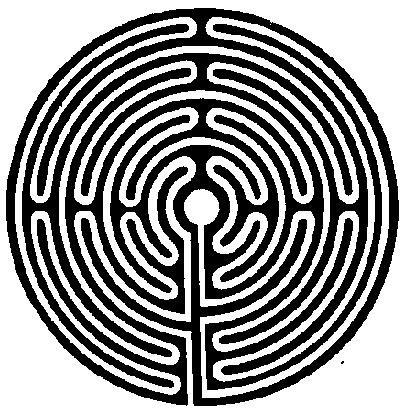

At the places where the dividing line crosses the actual line of the path we find the exact points from where the geometry takes shape. Added to these three points are four more which are derived from a diagonal line that connects beginning and end of the path and which runs exactly through the centre.
The strange thing about these points is that they are not there by chance but in fact dictate the position and proportion of the various geometrical forms which are part of a most splendid geometrical composition. Once the straightened baseline of the Labyrinth is established, the geometry almost automatically takes over. Two large circles can be drawn with their centre in A and B and with a radius from their centre to the beginning or end of the baseline. When a third and smaller circle is drawn which has its centre in the middle of the baseline and a radius from this point to where both large circles intersect, you see that the line of this circle goes exactly through points C and D. The result of this drawing of circles is an image which shows once again that the seemingly random position of the various points on the baseline are in fact well calculated and demonstrate a high sense of balance and proportion. Besides this, another remarkable thing becomes clear when you take a close look at the baseline of the Labyrinth. The beginning and end of this line are the same and the true centre of the baseline, and therefore also the true centre of the Labyrinth, is not the middle of this circular symbol but a point that is situated exactly between the middle of this circular form and its upper edge. Once you have arrived at this stage of unravelling this ancient symbol, it can no longer be denied that it proves to be much, much more than just a decorative object with a nice myth attached to it. All you need here is a pair of compasses, a ruler and a good sense of logic. The circles almost invite you to think of a logical next step, for instance to use the length of their radius. Measuring out the length of the radius on the circumference of the respective circles results in the appearance of two hexagrams, one in the small and one in the large circle.
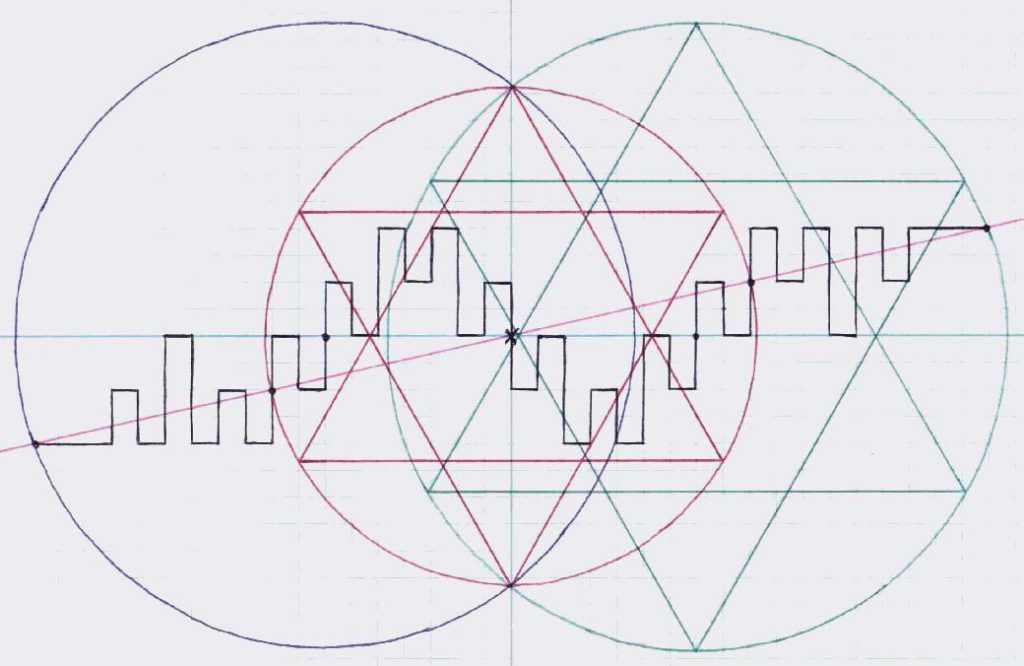
A next geometrical form can be derived from the points which depict the centre of both large circles. When you take the distance between the centres of both large circles and use this measurement to draw a square which is centred on the composition, a remarkable thing happens. The most upper point of the large and the small hexagram and the left hand upper corner of the square appear to be exactly in line. And when you use the distance between the centre of the path and the upper point of the large hexagram and measure-out this distance on the left hand large circle, a pentagram appears inside this circle.
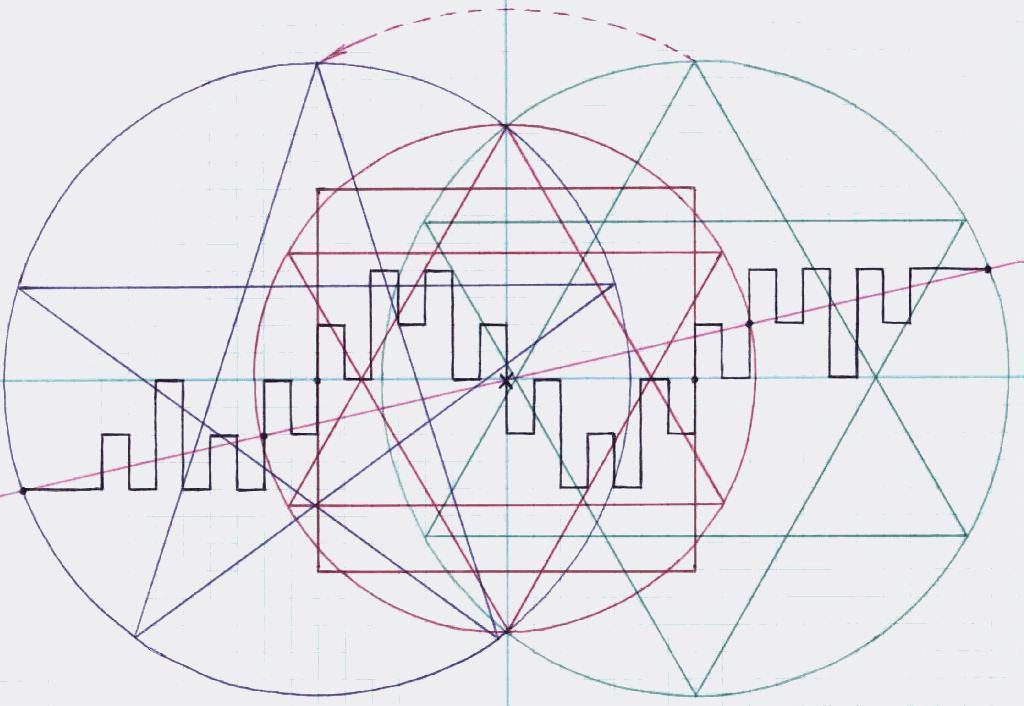
The left hand upper point of this pentagram is also in line with the upper points of both hexagrams and the left hand upper corner of the square. This pentagram can also be obtained by drawing a line from the right hand lower point of the large hexagram to the topside of the left hand large circle. The places where this line touches on the left hand circle will give the distance between two points of the pentagram and this distance can be measured out on the circumference of this circle. The initially bizarre baseline of the Labyrinth proves to be not that bizarre after all for it generates a number of specific points which in their turn generate a well-balanced and extremely close-fitting geometrical composition. Several alignments exist inside this composition, especially between the pentagram and the large hexagram.
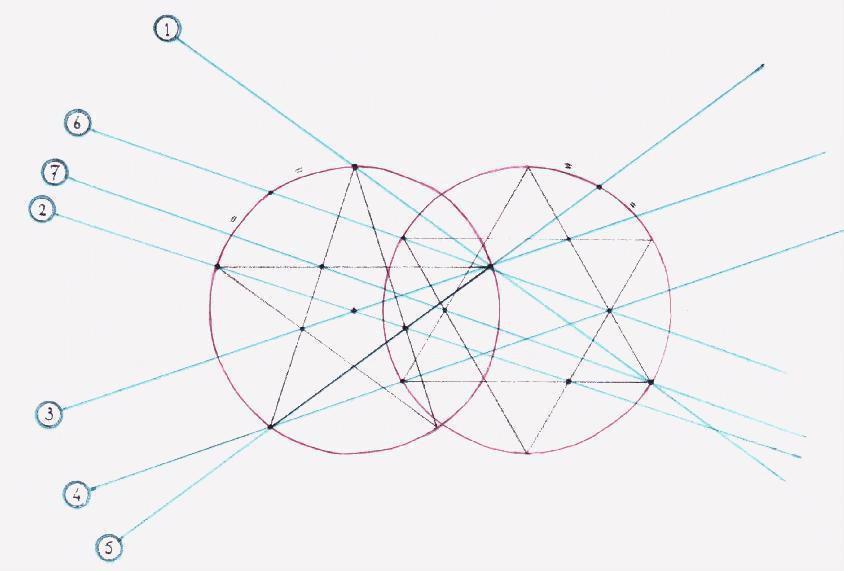
The relative positions of both geometrical forms which were dictated by the relative distances between the various points in the labyrinthine path suggest that there is a certain geometrical interplay at work inside this composition. Besides all this, a last and most remarkable geometrical form can be derived from this composition. When you extend the vertical lines of the square and draw a line over the topside and bottom side of both large circles, a rectangle appears in the composition. This rectangle increases the meaning of the Labyrinth in an enormous way for the length of its sides appear to possess the exact proportions of the Golden Number.
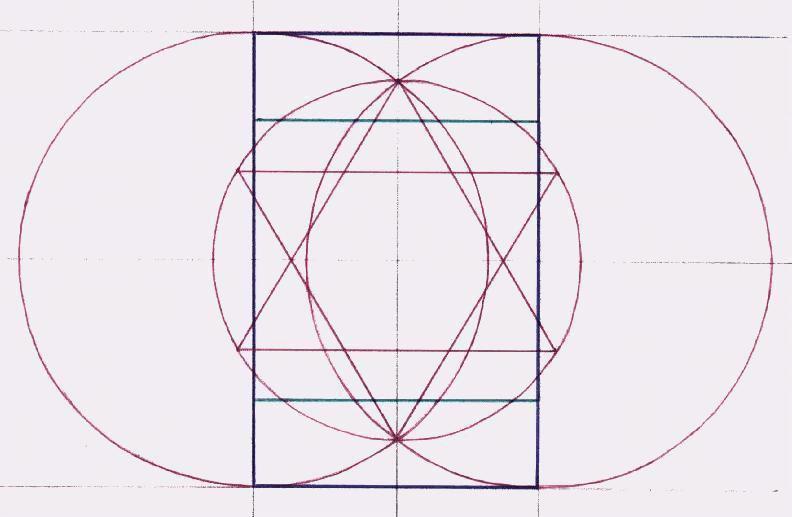
This cosmic rule governs all life on this planet and can be seen for instance in the distance between buds on a branch or in the pattern of certain seashells. All in all the Labyrinth harbours a most fascinating world of thought that demonstrates the laws of the universe through geometry and in this case a specific cosmic reality through the interplay between the various geometrical forms. This geometrical interplay which dictates size, form and position of all its components provides you with the very key by means of which you can actually read the ancient structures. All you have to do is search hard for the inherent geometry inside these structures and then apply your key. The geometry you are looking for inside the structures should be the same as the geometrical components inside the Labyrinth. Next to circles, you should look for hexagrams, pentagrams, squares, triangles, hexagons and pentagons. Besides this, the geometrical forms you might find must stand in a close relationship to and must preferably be generated by each other.
Much the same as is the case inside the geometry of the Labyrinth, the major working elements inside the geometry of the structure must be the hexagram and the pentagram. Geometrically speaking, both these forms have the closest relationship inside the Labyrinth. All other geometrical forms seem to be solely there for the purpose of establishing the relative proportions and positions of these two. If the hexagram and the pentagram are the major players inside the geometrical clockwork, you should find the numericals of Precession in the numerical values of these two or in their combination. And so you will. The cycle of Precession gives the ciphers: 360°(the circle of the Ecliptica), 1°(72 years), 30°(2160 years), 12 (the number of signs of the Zodiac), 25.920 (12×2160), and many variations on this data like: 432(6×72), 144(12×12 or 72×2), 108(72+36), 360(5×72 or 6×60) and so on. The hexagram generates the ciphers: 360°(circle), the angle of 60°, the angle of 30°, 12 (the number of spaces of 30° on the circle), 6 (the number of spaces of 60° on the circle. The pentagram gives the ciphers: 360°(circle), the angle of 108°, the angle of 72°, the angle of 54°, the angle of 36°, 5 (the number of spaces of 72° on the circle).
It is obvious that all of the numerical data of the cycle of Precession are also present in the combination of the hexagram and the pentagram. It is therefore very well possible to design and build a structure with geometrical features that represent in full detail the way in which Precession works. When you investigate whether this is the case with the ancient structures that you can still see today, you will find that they are all constructed on the basis of the star of Bethlehem which was hidden within the structure of the Labyrinth.
29-04-2008
Moshiya van den Broek
Based on research by H.P.M.Klaassen.
